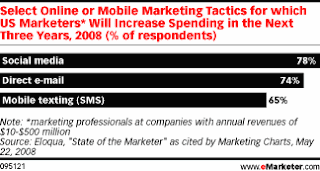Welcome to Hell Week
I've been a road warrior during the last few months and I can tell you, there is nothing sexy about it. Don't get me wrong, I've stayed in nice hotels, eaten decent meals, met with interesting (and sometimes famous) people. But it gets tired fast. Anyone that travels a lot knows what I'm talking about. You miss your family. You find yourself completely in reactive mode when it comes to work. Meetings get pushed off, and then pushed off again. Your sleep suffers.
Last week was worth it though. We had what we affectionately call "Hell Week" out in Las Vegas. Four conferences (
Community 2.0,
Warrillow Summit,
ACORD/LOMA,
Sirius Decisions) in five days including three keynotes from our
chairman, two panels that I participated in, dozens of podcasts, video interviews and sponsorships at each event. It was exhausting but really ended up being a "tour de force" for both Mzinga, and We Are Smarter.
To hear some of the podcasts that
Jim,
Bryan Person (our client and podcast producer) and myself did while we were at Community 2.0, head over to
Jim's blog. You can also see a complete list of the
podcasts here on the C20 blog. The videos will be coming soon.
My colleague, Shannon took a number of pictures that are up on
Flickr (I have a bunch I need to post too - also coming soon).
Here are some high level observations from the Community 2.0 Conference:
- Great collection of smart community people. I knew a number of the speakers/attendees already because of last year's event, my We Are Smarter podcasts or Bill Johnston's ForumOne events. I did meet a few new peeps which is always fun.
- One of the highlights of the trip was picking up Charlene Li of Forrester at the airport at 12:30 AM on Tuesday so that we could podcast with her. I think she thought my colleague, Jim Storer, and I were slightly crazy but she was a good sport about it.
- We held a disco/bowling party Tuesday night for clients and friends of Mzinga. It was really quite amusing and we bowled our ASSES off. By the end of the night, I wasn't half bad. I will say this much though, real bowling and bowling on the Wii are not even in the same universe from a skill set perspective.
- David Weinberger is an incredibly brilliant but shy person. He's much more self aware than people give him credit for and his keynote was brilliant. I had the pleasure of podcasting with him and talking with him for about 45 minutes at the Community 2.0 kickoff party Monday night. At one point in the conversation, he said "STOP INTERVIEWING ME!" I laughed and told him it was hard - my job is to ask people questions. He and I joked about it his brutal honesty for the rest of the conference - he apologized - I told him he was just keeping me honest.
- Tony Hsieh of Zappos is an incredibly cool dude. He is one of the most social media-savvy CEO's I know (Jason Calacanis excepted). We podcasted with him as well and got to ask him questions my wife wanted answers to. One such question was "why does your UI kind of suck?" I didn't put it quite that bluntly but his answer was, "we're fixing it and tell your wife to go to http://zeta.zapos.com" (beta version of the site).
- I also had some great conversations with KD Paine - the queen of social media measurement (we did a video interview), Rachel Makool of eBay, Peter Friedman of Liveworld, Mike Walsh of Leverage Software, Shel Israel, and many many more smart social media peeps.
I didn't take a ton of notes but here are some take aways I jotted down during Charlene Li and David Weinberger's sessions:
Charlene Li's Keynote: May 13 (Community 2.0 Conference)Reviewed Groundswell and why it matters:
Case studies:
- Del Monte - Market research for their dogfoo (pdf) - people give great, immediate, feedback
- Tivo Community (didn't own it - but they participate)
- BlendTec - Will it Blend videos were a great way to
- P&G's Beinggirl.com - great way to get research on teen girls use of tampons (it's a site focused on teenage girl things, not feminine products) - math in the book shows lifetime profit/girl that buys is $480 (girls tend to stick w/ brand they started with)
- E&Y - doing a great job with their Facebook presence - great at having conversations with recruits
- Fiskars - Scissors used in scrapbooking - went out and asked "what question do you think of when you hear 'Fiskars'" - response was "beige" - Fiskars didn't like this so worked with "Fiskateers" (WOM advocates) - saw a correlation between activity and in local forums and local store sales
- Dell - support forums - "Predator" spends 40 hours/week answering questions about optical drives for Dell customers (is not an employee) - asked him why and he said "I really enjoy helping people.
- Blueshirt Nation - (great podcast) employee communities - great for internal innovation, information sharing.
- Starbucks innovation - currently soliciting feedback via idea catcher - they respond!
- Talked about ROI of executive blogging - for $285K spent (estimates) by GM on Fastlane blogs, ROI was $353K.
- Dell - talked about Jeff Jarvis' "
Dell Hell"/flaming laptop precipitating a blogging team (lead by Lionel Menchaca) - in spite of tons of negative intitial feedback, Dell stuck with it (Mike Dell e-mailed Lionel in the thick of things at 1:00 AM to tell him that he was doing a great job!)
- Charlene asked how many of us know how many customer touch points we have? We should be asking ourselves this question.
David Weinberger's Keynote: May 13 (Community 2.0 Conference)- A real community is a group of people that care about each more than they really need to
- Real conversations are voluntary, open-ended, in your own voice
- Imagagine the worst boss (show's Dick Cheney)
- Showed laughing baby from Youtube - convserations are facilitated by passing around consumer generated content
- Everything we do is social (60K comments on the laughing baby video on Youtube)
- Web/conversations online are important during the "age of conversation" in the "age of information" - we can now go to the end user to ask them questions like, "how's the Mini in the winter in Boston?"
- Informationalization - "Statement - DNA is not information" (we show ourselves views of DNA over and over again as information) but it really isn't what DNA looks like. It's not information (the world is made out of "stuff")
- Ray Kurzweil - wrote The Age of Spirtual Machines - when will computers be powerful enough so that we can create a perfect model of the brain (by 2029). Ray believes that if he can model the brain, when he dies, he will live on forever. Key is that the model of something "isn't" something. It's just a representation.
- Databases are great, but...
- LOC receives 7,000 new books/day - they have a system for this but this isn't scalable. There are tens of millions or hundreds of millions of items updated to the Web every day.
- Control doesn't scale (at least not well - China is finding this out now). You need to spend all your time trying to "control" - the Web was built so that it didn't require centralized control - this allowed it to grow, scale and ultimately succeed (we didn't need to figure out a way to manage 60K comments on a laughing baby video)
- Too much abundance (good and bad) on Web - we manage e-mail in spite of the spam.
- First order: Filling cabinet (one person's filing system)
- Second order: file card library (group organization analog style) - ensures that we must throw out most of the content in order to keep things organized
- Third order: Amazon is able to do this with data using tag clouds, taxonomies, links, and all sorts of other types of meta data (basically) - user reviews
- KEY: Users are now in charge of the organizing of information - (We companies let customers organize - ME companies still insist they control and that they are in charge)
- Library of Congress put up 3,000 pictures on Flickr that they weren't able to categorize - end-users added dozens of tags and comments to these pictures (Flickr, only allows for 75 tags - people "hacked" comments to add additional tags)
- With newspapers, only one front page is possible. In digital world, blogs, forums, Twitter, digg and many other social media activities are all new front pages!
- Talked a bit about the importance of Twitter.
- Britannica works but doesn't scale. Couldn't get to Wikipedia's scalle (millions of posts/entries in just five years)
Some Twitter/blog coverage and from the event:If you know of other stuff I'm missing (I'm sure there's plenty) please let me know via comments or DM me on
Twitter.
Best,
Aaron








